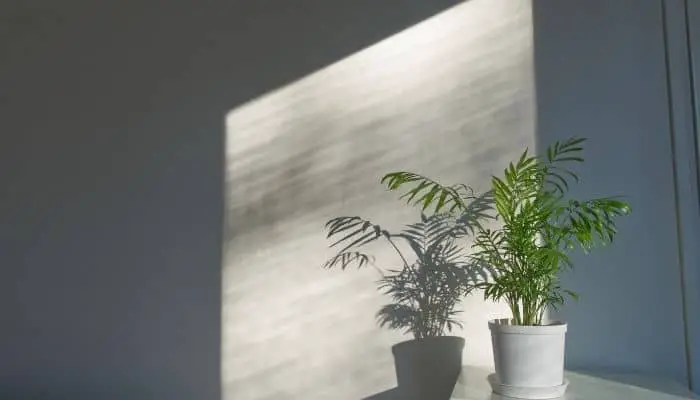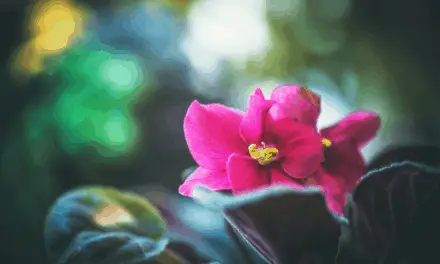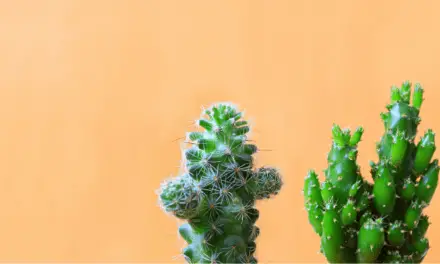A parlor palm is a lovely low-maintenance plant that can give any space a lavish, tropical look.
They are also slow-growing, so when you find the perfect spot for one, it will look good there for quite some time.
But when these plants do get big, they often become a little top-heavy and unstable.
In this article, we’re going to look at why parlor palms sometimes fall over and how you can prevent this from happening to yours.
Table of Contents
Why Is My Parlor Palm Falling Over?

Parlor palms usually fall over when they become large, top-heavy, and unbalanced.
But they may also fall over more easily if they are not cared for properly and subjected to prolonged overwatering or exposure to direct sunlight.
These plants are native to Central America and can be found growing in dappled shade on the forest floor.
Indirect light is key to keeping this plant in good health.
Placing it in strong direct sunlight for extended periods will soon weaken it, cause its health to decline, and make it more at risk of falling over.
Parlor palms also like to be kept moist.
But, if overwatered they are susceptible to root rot which can cause them to become unstable and start falling over.
Parlor Palms May Fall Over If They Become Top-Heavy And Unbalanced
Parlor palms are naturally top-heavy and susceptible to falling over under their weight
You will find that many garden centers stake these plants early on, just to keep them growing straight.
A well-looked-after palm that’s given lots of bright indirect sunlight can grow to be several feet tall, eventually outgrowing its pot and the space you provided for it.
Parlor palms usually develop new growth at the top so as they become older and taller they become more unstable.
It’s important to keep an eye on these plants as they grow bigger, just to make sure their weight is not beginning to lean one way or the other.
It’s much easier to deal with the problem while your plant still wants to stand up by itself.
To prevent your plant from becoming too heavy on one side or the other, move it around and rotate it now and then so that its leaves received an even amount of sunlight and don’t grow more on one side.
If your parlor palm is already big and falling over because it is top-heavy, you will need to steady it up.
Put Your Parlor Palm’s Pot In A Larger Pot
Find a larger, heavier pot and fill it up halfway with stones.
Then put your parlor palm’s pot inside the bigger one to steady it up.
Related Article: How To Keep A Ponytail Palm Small? (3 Ways That Work)
Brace Your Parlor Palm
If you don’t have the space to go with a larger pot, you may need to brace your palm.
Depending on your plant’s size, one stake may not do the job.
You can tie the plant’s stems together and use two or three stakes pushed into the soil around the center of the plant to help support it.
You can use string or twisty ties to tie the stems to the stakes.
How To Straighten Your Parlor Palm
If your parlor palm is falling over due to bad health, you’ll have to examine the situation before you try to straighten it.
It may not be a good idea to force the plant straight if the leaning is dramatic.
Try to lift it just enough so it doesn’t fall out of the pot and expose the roots.
Before inspecting your plant, ask yourself the following questions:
- Does the plant get enough light and humidity?
- Is the plant in the way of drafts and is it kept at the right temperature?
- Is the soil too wet or dry?
- Is there an odor coming from the soil?
- Are there plenty of drainage holes in the pot?
- Is the pot the right size?
- Are the leaves also showing signs of discoloration, curling, or wilting?
- Do you notice any pests or diseases?
How To Care For Your Parlor Palm So It Doesn’t Fall Over?
To ensure your parlor palm does not fall over in the future, it’s best to pay special attention to its needs so as it gets better it will remain strong and steady.
Soil
Regular gardening soil should never be in a pot for parlor palms.
A blend of 30% perlite, 10% compost, and 60% peat is most will work well.
Overwatering And Root Rot
When it comes to the parlor palm, underwatering is a lot safer than overwatering.
These plants will not tolerate overwatering.
If the leaves start looking a bit droopy and mushy it’s a sign of overwatering.
And if you notice a bad smell arising from the soil, it’s a case of root rot.
When the roots are rotting, the plant can no longer absorb moisture and nutrients.
This will begin to weaken the structure of your parlor palm, loosen the hold that it has within the soil, and may cause it to fall over.
It’s best to use a soil moisture meter and only give your plant water when the soil is dry to about halfway down the pot.
Preventing Root Rot
To prevent rot, ensure the soil moistens completely and that all excess water is allowed to drain away from the roots so that your plant is never sitting in water.
Root rot can also occur if the pot is too large, the soil is inappropriate or there aren’t enough drainage holes.
Unfortunately, it’s hard to save a parlor palm if the rot is severe.
If you catch root rot early, you can report the plant into fresh soil and keep it somewhere where there’s good air circulation.
Underwatering
Even though parlor palms are very drought resistant, severe under watering will cause the plant to droop and lean over.
If underwatered, the leaves will look dry and the pot will feel light.
Check If Your Parlor Palm Is Rootbound
If dryness is a constant problem, the plant could be rootbound.
This means the roots have overtaken the soil and may not be receiving enough water or nutrients.
If the plant’s roots look like they have completely taken over and are even making the pot bulge out, then it is rootbound and needs to be repotted into a pot that’s one or two inches bigger than the old one.
Also, note that parlor palms require more water in the spring and summer than they do in the fall and winter.
Repotting
Repotted parlor palms often lean and droop at first due to shock.
Leave the plant alone for a couple of days to see if the problem corrects itself.
If not, use a stake and pieces of string to support it.
Ensure the plant gets the right conditions and avoid fertilizing until it’s healthy again.
Sunlight
These plants like lots of bright indirect sunlight but they can also do well in lower light conditions – they will just grow a lot slower.
To stop your parlor palm from eventually becoming unbalanced and falling over, try to ensure that it is receiving an even amount of light.
Your plant will grow towards the light.
This will cause one side to become heavier and for your plant to become unstable.
To prevent this, rotate your plant once every few days to ensure that its leaves are receiving an even amount of sunlight.
Temperature And Humidity
The best temperature range for parlor palms is between 65F and 80F.
It’s handy because that’s roughly the temperature most homes are kept at.
If you feel comfy your parlor palm is probably fine too.
It can go as low as 50F, but any lower, and the plant will start to struggle.
Be careful that your plant is not sitting beside a drafty door or window.
Drafty windows and vents can impact temperature as well as humidity.
Parlor Palms do like a bit of humidity and may become droopy if your home gets very dry – especially in winter when the home heating is on.
The first sign that humidity may be too low is the tips of the leaves becoming a bit brown and crispy.
To raise humidity for this plant you can group it together with other plants, keep it in a bathroom or invest in a humidifier.
Fertilizer
Too much fertilizer may also cause a parlor palm to lean, indicated by crusty salt deposits on the soil.
Only fertilize the plant once a month during the growing season and don’t fertilize in the fall or wintertime.
Mix, at half strength, a balanced fertilizer so as not to burn its roots.
Final Thoughts
The parlor palm is a great non-toxic plant that’s safe around kids and pets.
Although these plants are slow growers, they do get quite big and can become unbalanced.
Parlor palms can sometimes become unsteady and fall over under their own weight, especially if they have been growing for long periods under uneven levels of sunlight.
By following along with this guide, I’m sure you’ll be able to care for your parlor palm so that you never have to worry about it falling over.




